Characteristics:
|
Original
(WICKES (Little) class)
|
Original
(WICKES (Lamberton) class) |
Original
(CLEMSON class) |
Early WWII
|
Final
|
| Displacement |
1,154 tons
|
1,213 tons
|
1,215 tons
|
1,069
tons
(1,190 for BUXTON, ST CROIX, and ST FRANCIS) |
| Dimensions |
95.7 x
9.3 x 2.7 meters (314 x 30.5 x 9 feet)
|
| Propulsion |
Twin
shafts;
4 - Yarrow water tube boilers;
2 - Curtis geared turbines, 24,200 shp;
35 knots
|
Twin
shafts;
4 - Thornycroft boilers;
2 - Parsons geared cruise turbines;
2 - direct drive turbines, 24,900 shp;
35 knots |
Twin
shafts;
4 - Yarrow water tube boilers;
2 - Curtis geared turbines, 26,500 shp;
35 knots |
Same as original, except:
Some ships had 4th boiler removed.
Speed generally reduced to 28 knots due to age. |
| Range |
The fuel
bunkers carried, and thus the range, of these ships varied between
sub-classes. The CLEMSON class, on average, carried 35% more fuel than
the WICKES class, and the range of the WICKES class ships varied
between the sub-classes. In general, these ships were not capable of
crossing the Atlantic without refuelling, and some ships may have had
additional fuel tanks added in place of a boiler.
|
| Crew |
103 |
101
|
114
|
153
|
| Radar |
None
|
SW1C /
SW2C
or
Type 286 (ST. FRANCIS & ST. CLAIR)
|
SW1C or
SW2C
Type 271
|
| Sonar |
Probably
none.
|
Unknown,
but presumably an early-war set such as Type 123 or 124. |
| Fire
Control |
None.
|
| EW |
None. |
| Armament |
3 or 4 -
4"/50 Mk.9 singles;
2 - 3"/23 AA;
12 - 21" torpedo tubes
|
1 or 3 -
4"/50 Mk.9 singles;
1 - 3"/40 Mk.V AA single;
2 or 4 20mm Oerlikon AA;
3 - 21" torpedo tubes;
4 MK.I DCT;
2 depth charge rails.
|
1 or 3 -
4"/50 Mk.9 singles;
1 - 3"/40 Mk.V AA single;
2 or 4 20mm Oerlikon AA;
3 - 21" torpedo tubes;
1 Hedgehog ASW mortar;
4 MK.I DCT;
2 depth charge rails. |
|
Original
(WICKES (Little) class)
|
Original
(WICKES (Lamberton) class) |
Original
(CLEMSON class) |
Early WWII
|
Final
|

Ships:
|
Name
|
Pendant
|
Commissioned
|
Paid Off
|
Notes
|
|
ANNAPOLIS
|
I04
|
24/9/40
|
4/6/45
|
WICKES (Little) class, Ex-USS MACKENZIE
|
|
BUXTON
|
H96
|
4/11/43
|
2/6/45
|
CLEMSON class, Ex-USS EDWARDS
|
|
COLUMBIA
|
I49
|
24/9/40
|
17/3/44
|
WICKES (Lamberton), Ex-USS HARADEN
|
|
HAMILTON
|
I24
|
6/7/41
|
8/6/45
|
WICKES (Little) class, Ex-USS KALK
|
|
NIAGARA
|
I57
|
24/9/40
|
15/9/45
|
WICKES (Little) class, Ex-USS THATCHER
|
|
ST CLAIR
|
I65
|
24/9/40
|
23/8/44
|
WICKES (Little) class, Ex-USS WILLIAMS
|
|
ST CROIX
|
I81
|
24/9/40
|
20/9/43
|
CLEMSON class, Ex-USS McCOOK, Sunk 20/9/43.
|
|
ST FRANCIS
|
I93
|
24/9/40
|
11/6/45
|
CLEMSON class, Ex-USS BANCROFT
|

Notes:
This class of overage WWI US destroyers were among the 50 such
ships given to the RN under the Lend-Lease program, six of which almost
immediately reverted to the RCN, with two transferred later. The RN
ships were named after British towns, but the RCN examples were named
after border rivers with the exception of ANNAPOLIS, BUXTON, and
HAMILTON. At a desperate time in the Battle of the Atlantic, these
ships helped to fill a great void in both the Royal and Royal Canadian
Navies.
These ships, alternatively called "flush-deckers" and
"four-stackers", were not a homogenous class and consisted of the two
main WICKES and CLEMSON classes with various sub-classes built in
different shipyards to differing designs, and there was a variety of
equipment and machinery fitted. The WICKES class in particular was made
up of Bath, Little, and Lamberton sub-classes. Although good for their
day, these ships were very wet in heavy seas, were top heavy
necessitating the removal of some equipment before assuming their new
ASW role, and had very poor turning circles. They were also quite worn
out by the time they entered service with the RCN.
As originally laid down by the USN, they carried up to four
4"/50 guns, the forward gun ahead of the bridge with a gun shield, two
port and starboard aft of the bridge (midships), and one right aft at
the stern. The latter gun was replaced with depth charge rails when
they entered Canadian service, and some ships lost the midships pair as
well, to have them replaced with AA armament. The twelve torpedo tubes
were arranged in triple mountings, in two port and starboard sets aft
of amidships. Most of the torpedo tubes were removed, leaving only one
triple mounting relocated to the centreline in order to save weight and
make room for a 3" AA mounting. Some ships, such as ANNAPOLIS and
COLUMBIA, lost boilers either to increase fuel storage, or when a
boiler burned out.
On September 20, 1943, ST CROIX was
sunk by a torpedo, and only 81 men were saved. When HMS ITCHEN was sunk
two
days later, only one of these survived. Many of the class suffered from
mechanical problems, and were relegated to the torpedo training role.
All were paid off
soon after the war's end.
For more photos and information on this class of ships, please
refer to the HMCS
COLUMBIA and HMS
LEAMINGTON photo features in the Battle of the
Atlantic section of the Haze Gray site.

Photos:
|
ANNAPOLIS
|
|
Notes:
|
1. ANNAPOLIS at anchor.
Her fourth funnel was cut down after the fourth boiler burned out and
was removed. The ship sports both a SW1C radar at the mast head as well
as the Type 271 in the lantern before the mast. Photo courtesy of James
Doiron.
|
|
1
|
2
|
3
|
4
|
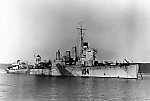
|
|
|
|
|
|
|
COLUMBIA
|
|
Notes:
|
1. COLUMBIA fairly early
on in the war, with the SW1C radar antenna installed at the mast head
but before the Type 271 had been installed. Photo courtesy of John
Sadler.
2. Taken about the same time as the first photo. Photo courtesy of John
Sadler.
3. Taken very early on, with the full fit of twelve torpedo tubes,
prior to the removal of 9 of them. Photo courtesy of RCL White Ensign.
|
|
1
|
2
|
3
|
4
|
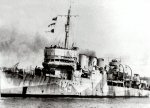
|
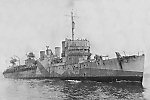
|

|
|
|
|
HAMILTON
|
|
Notes:
|
1. HMCS HAMILTON, shown
here, suffered several collisions and a grounding, and never actually
crossed the Atlantic during the Second World War. She
was allocated to HMCS Cornwallis as a training ship in 1943. DND photo,
Courtesy of Bill Croshaw.
|
|
1
|
2
|
3
|
4
|
 |
|
|
|
|
|
NIAGARA
|
|
Notes:
|
1. A TOWN class
destroyer, almost certainly HMCS NIAGARA based on the resemblance
between the first two photos,
either just before or after being handed over from the USN. The
degaussing
wire is visible on the hull. Photo courtesy of Bjoern Rehnfeldt.
2. HMCS NIAGARA, again very early on in her RCN career, with a full
complement of torpedo tubes fitted. The wire running the perimeter of
the ship
is for degaussing it. DND photo, Courtesy of Dave Shirlaw.
3. Taken fairly early on in the war, the torpedo tube complement has
been reduced and a 3"/40 gun added aft, but before the fitting of the
Type 271 radar. DND photo, Courtesy of Dave Shirlaw. |
|
1
|
2
|
3
|
4
|
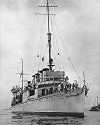 |
 |
 |
|
|
|
ST. CLAIR
|
|
Notes:
|
1. Taken in Halifax
Harbour, ST. CLAIR appears to have a Type 286 radar antenna installed
at the mast head. Photo courtesy of Gord Condie and Bill Croshaw.
2.
|
|
1
|
2
|
3
|
4
|

|
|
|
|
|
|
ST. CROIX
|
|
Notes:
|
1. ST. CROIX (possibly
as USS MCCOOK) is closest to the wharf, and is painted in USN colours
with a USN hull number visible.
Before being sunk, she was probably the most successful TOWN class ship
in the RCN. DND photo, Courtesy of Dave Shirlaw.
2. A view of her deck. Photo courtesy of John Cosgrove.
|
|
1
|
2
|
3
|
4
|

|
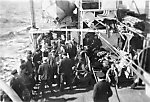
|
|
|
|
|
ST. FRANCIS
|
|
Notes:
|
|
|
1
|
2
|
3
|
4
|
|
|
|
|
|

Sources:
Barrie, Ron and Macpherson, Ken. (2002). This Ships of
Canada's Naval Forces 1910-2002. Vanwell Publishing Ltd. St.
Catherines, Ont.
Jane's Fighting Ships, Various Editions
NavSource
Destroyer Photo Archives web site.
Destroyer
History Foundation web site.
|







